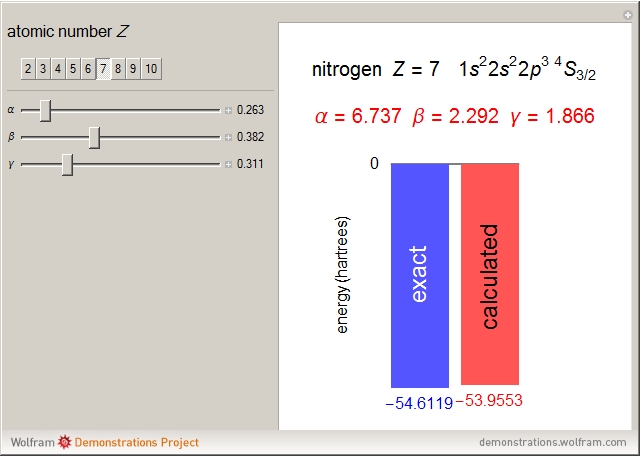Modern
computational quantum chemistry has developed largely from applications
of the Hartree–Fock method to atoms and molecules [1–3]. A simple
representation of a many-electron atom is given by a Slater determinant
constructed from

occupied spin-orbitals:
Following are results for optimized functions
ψ1 s,
ψ2 s and
ψ2 p. For comparison we also include results from the best Hartree-Fock computations and the exact atomic ground-state energies.
[1] S. M. Blinder, "Simplified Hartree-Fock Computations on Second-Row Atoms," https://arxiv.org/abs/2105.07018
[2] A. Szabo and N. S. Ostlund,
Modern Quantum Chemistry: Introduction to Advanced Electronic Structure Theory, Mineola, NY: Dover, 1996.
[3] S. M. Blinder, "Introduction to the Hartree–Fock Method," in
Mathematical Physics in Theoretical Chemistry (S. M. Blinder and J. E. House, eds.), Elsevier, 2018.
https://demonstrations.wolfram.com/SimplifiedHartreeFockComputationsOnSecondRowAtoms/






![[Snapshot]](https://demonstrations.wolfram.com/SimplifiedHartreeFockComputationsOnSecondRowAtoms/HTMLImages/index.en/thumbnail_1.gif)
![[Snapshot]](https://demonstrations.wolfram.com/SimplifiedHartreeFockComputationsOnSecondRowAtoms/HTMLImages/index.en/thumbnail_2.gif)
![[Snapshot]](https://demonstrations.wolfram.com/SimplifiedHartreeFockComputationsOnSecondRowAtoms/HTMLImages/index.en/thumbnail_3.gif)


0 Comments